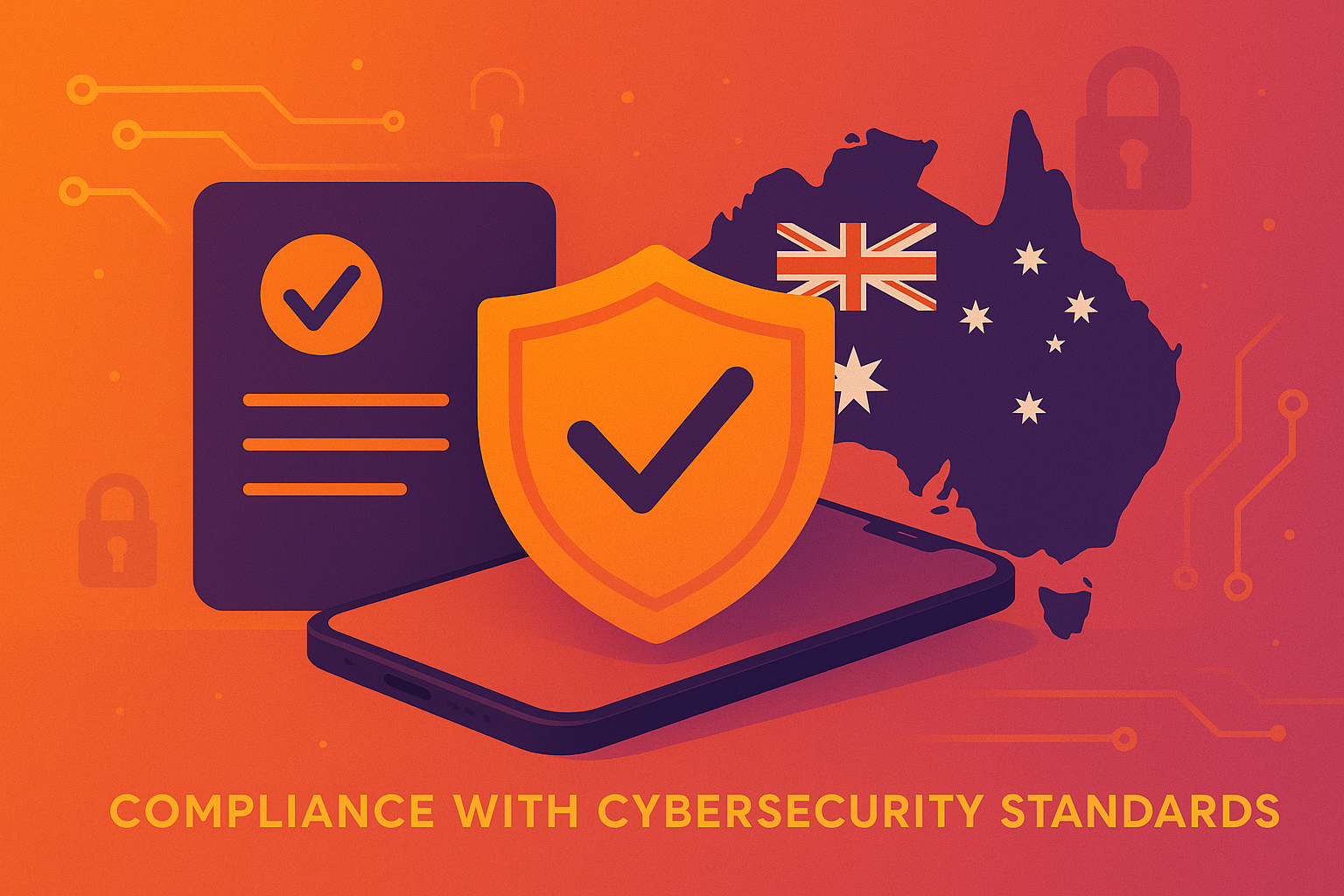Compliance with Cybersecurity Standards (Australia-Focused)
In an era where data breaches and privacy violations can trigger hefty fines and erode public trust, adhering to cybersecurity standards has become a top priority. From the Essential Eight (recommended by the Australian Cyber Security Centre) to the Australian Privacy Principles (APPs) (governing personal data handling), these frameworks set baseline requirements for keeping information secure. But each organisation’s blend of technologies and business needs can complicate achieving compliance. Ensuring you meet these standards isn’t just about ticking boxes - it’s about embedding robust security practices that protect users, customers, and your business reputation in the Australian context.
In this article, we’ll explore compliance with cybersecurity standards in Australia - why it matters, which guidelines often come into play, and best practices for maintaining alignment. We’ll also reference earlier discussions - like Vulnerability Management Best Practices and Data Encryption Strategies - to show how compliance fosters a well-rounded security posture. Whether you’re a small team on the Central Coast (NSW) or a multinational enterprise with local data centres, compliance ensures that you not only avoid penalties but also uphold a culture of data protection in an evolving threat landscape.
Why Cybersecurity Compliance Is Essential in Australia
Legal and Financial Consequences:
Regulators can impose stiff penalties for failing to protect personal data or critical systems - especially under the Australian Privacy Act and related legislation. Major breaches can result in investigations, fines, and long-term reputational damage.
Preserving Brand Trust:
Customers and partners prefer organisations that demonstrate proven security and compliance track records, especially in data-sensitive fields. Demonstrating alignment with ACSC guidelines or the Essential Eight fosters credibility.
Operational Resilience:
Many Australian guidelines emphasise robust disaster recovery and incident response plans. By following them, businesses can better withstand cyberattacks and minimise downtime.
Competitive Advantage:
Being able to show compliance with relevant Australian standards - like the Essential Eight maturity model - can open doors to local government contracts and reassure corporate clients.
Risk Reduction:
Following standardised processes (e.g., patching from the Essential Eight, encryption mandates in the Privacy Act) systematically lowers an organisation’s vulnerability to common exploits.
Common Cybersecurity Standards and Guidelines in Australia
Essential Eight (ACSC)
Scope: Australian Cyber Security Centre’s recommended strategies to prevent malware delivery, limit potential damage, and quickly recover.
Key Focus: Eight key mitigations - from application control and patching to macro settings and user privileges - divided into maturity levels.
Compliance Implications: Government entities often adopt or require the Essential Eight. Private organisations benefit by aligning internal policies with these proven controls.
Australian Privacy Principles (APPs)
Scope: Organisations handling personal data in Australia, typically with annual turnover over $3 million, or those who opt in.
Key Focus: Transparency in data handling, consent, data minimisation, secure storage, and mandatory breach notification for serious data breaches.
Compliance Implications: Non-compliance can lead to investigations by the Office of the Australian Information Commissioner (OAIC), with potential enforceable undertakings or financial penalties.
ISO 27001
Scope: An international standard also recognised in Australia for information security management systems (ISMS).
Key Focus: A risk-based approach ensuring policies, controls, and continuous improvement cycles around information security.
Compliance Implications: Achieving ISO 27001 certification shows a mature security posture to clients, boosting trust, though it’s not mandated by Australian law.
Other Local Regulations
Examples: Sector-specific mandates (e.g., APRA for financial services) or state-level data breach notification laws.
Key Focus: Protecting consumer data, ensuring operational resilience, clear breach reporting timelines.
Core Components of Cybersecurity Compliance in Australia
Risk Assessments
What: Evaluating threats, vulnerabilities, and potential impacts on data and systems.
Why: Many standards - from the Essential Eight’s focus on patching and restricted privileges, to APPs data protection - demand risk-based decisions.
Policies and Controls
What: Documenting rules for data access, password hygiene, encryption usage, vendor management, etc.
Why: Written policies provide the blueprint for consistent adherence, meeting or exceeding local regulatory expectations.
Monitoring and Logging
What: Collecting logs from servers, apps, network devices, and user activity, with real-time or near real-time alerts for anomalies.
Why: Detecting suspicious events promptly is key to limiting breaches, and logs provide evidence if regulatory bodies investigate.
Incident Response Plans
What: Incident Response Plans detail detection, containment, eradication, and recovery.
Why: Mandated breach reporting under the Privacy Act requires timely steps to notify affected individuals and the OAIC if personal data is exposed.
Continuous Improvement
What: Ongoing vulnerability scans, penetration testing, staff training, policy updates.
Why: Cyber threats evolve, as do business processes. Consistent re-evaluation keeps compliance relevant.
Best Practices for Achieving Compliance in Australia
Map Data Flows and Classify
Why: Understanding where personal or critical data resides (on-prem vs. cloud), and how it moves, is fundamental.
How: Draw data flow diagrams, label data by sensitivity, and ensure encryption or restricted access for high-risk categories.
Implement the Essential Eight Strategies
Why: The Australian Cyber Security Centre designed them to address the most prevalent cyberattacks - covering application control, patching, macros, user privileges, and more.
How: Assess your current maturity across the eight mitigations, set target levels, and plan step-by-step improvements.
Enforce Access Controls and MFA
Why: Minimising account hijack risk is crucial, especially given many data breaches stem from compromised credentials.
How: Adopt multi-factor authentication (MFA), role-based access, and network segmentation for critical systems.
Regular Training and Audits
Why: Staff must understand compliance obligations, from secure data handling to breach notification timelines.
How: Integrate cybersecurity training, run internal or external audits that review both technical and policy aspects.
Document and Demonstrate Compliance
Why: Auditors or agencies may demand evidence (like patch logs, policies, or incident response records).
How: Keep centralised documentation, ensuring changes are version-controlled. Tools like GRC (Governance, Risk, and Compliance) software help unify evidence.
Common Compliance Challenges
Overlapping or Conflicting Requirements
Problem: A company may follow the Essential Eight plus other sector-specific rules (e.g., APRA guidelines for finance).
Solution: Build a single internal framework mapping each requirement to relevant controls, minimising duplication.
Cloud and Hybrid Complexity
Problem: Shared responsibility with cloud providers can obscure who handles encryption, patching, or logging.
Solution: Clarify responsibilities in service agreements. Use cloud-native security features aligning with local data residency needs (for instance, choosing Australian-based data centres).
Staff Resistance
Problem: Employees may see compliance steps (like frequent patching, mandatory MFA) as nuisances.
Solution: Highlight the rationale - protecting both company and personal info. Offer user-friendly solutions, run awareness campaigns.
Small Business Resources
Problem: Smaller teams might lack the budget or expertise to handle ongoing compliance tasks.
Solution: Outsource partial or full compliance efforts to Managed IT Services, focusing on cost-effective solutions aligned with essential data protections.
Tools and Approaches for Australian Compliance
Compliance Management Software
Role: Tracking controls, mapping them to the Essential Eight or APPs, generating audit logs or gap analyses.
Benefit: Centralises tasks, proof, and progress for internal or external scrutiny.
Automated Scans and Configuration Checks
Examples: Tools scanning systems to ensure compliance with ACSC guidelines, verifying mandatory patches or restricted admin privileges.
Outcome: Minimises manual overhead, quickly flags deviations from secure baselines.
Continuous Monitoring
Why: Real-time log correlation (via SIEM or similar) meets ACSC recommendations for suspicious activity detection, plus local breach notification laws.
Benefit: Quickly spots anomalies, shortens response times, and simplifies post-incident investigation.
How a Managed IT Services Provider Fits
A Managed IT Services partner can:
Identify Applicable Frameworks: Determining which Australian standards or guidelines apply based on data sensitivity, industry, or scale (e.g., Essential Eight maturity, APP obligations).
Gap Analysis: Comparing current security posture to mandated controls, producing a prioritised improvement roadmap.
Implementation: Deploying encryption, multi-factor authentication, or segmentation solutions to address compliance holes.
Documentation and Audit Prep: Maintaining policy libraries, collecting logs, generating compliance evidence for audits or official requests.
Ongoing Oversight: Scheduling vulnerability scans, patch cycles, staff training refreshers, and ensuring that new systems align with compliance from day one.
For advice on choosing a compliance-capable MSP, see How to Choose a Managed IT Provider.
Measuring Compliance Progress
Building on Evaluating Managed IT Performance, compliance metrics include:
Number of Outstanding Non-Compliance Issues:
Whether from internal checks or external audits, aim to address them promptly.
Time to Remediate:
Speedy closure of compliance gaps indicates effective internal processes and management buy-in.
Incident Rates:
Well-aligned organisations often experience fewer major incidents or detect them faster.
Audit or Assessment Outcomes:
Fewer critical findings or repeat issues signal a maturing compliance posture.
Employee Adoption:
Track how staff comply with mandated changes (e.g., mandatory MFA, secure data handling). Are awareness sessions reducing policy violations?
Why Partner with Zelrose IT?
At Zelrose IT, we integrate compliance with cybersecurity - ensuring Australian frameworks like the Essential Eight and APPs are baked into daily operations, not treated as an afterthought. Our approach includes:
Local Expertise: Familiarity with Australian standards, local data residency requirements, and ACSC best practices.
End-to-End Security: From endpoint solutions to network segmentation and incident response, aligning each control with compliance.
Documentation and Reporting: Detailed policies, logs, and progress metrics that satisfy audits or internal reviews.
Remediation Assistance: Handling patch deployments, encryption setups, or staff training for consistent compliance.
Ongoing Improvement: Monitoring for new ACSC updates, refining your posture as threats or business processes evolve.
Want a compliance strategy that meets Australian standards and genuinely boosts security? Contact us - we’ll craft solutions tailored to your environment, bridging local legal needs with actionable best practices.
Compliance with cybersecurity standards in Australia extends beyond mere box-ticking - it shapes a disciplined, methodical approach that keeps data and operations safe while instilling customer trust. Whether aligning with the Essential Eight, Australian Privacy Principles, or general best practices like ISO 27001, each framework enforces risk assessments, policy enforcement, and continuous monitoring. By embedding these steps into everyday operations, organisations reduce vulnerability to data breaches, avoid costly penalties, and build a security-conscious culture.
Achieving compliance involves balancing thoroughness (closing known gaps) with practicality (avoiding unnecessary red tape). Partnering with a Managed IT Services provider can alleviate resource strains, ensuring you stay updated on local guidelines, maintain thorough documentation, and systematically address evolving threats. Ultimately, compliance stands as both a protective shield and a business enabler - empowering growth, trust, and resilience in the face of rising cyber challenges.
Looking to unify your cybersecurity and compliance efforts?
Reach out to Zelrose IT. We’ll map your environment to Australian standards, patch vulnerabilities, train staff, and produce audit-ready evidence - transforming compliance tasks into tangible, risk-reducing benefits for your organisation.



